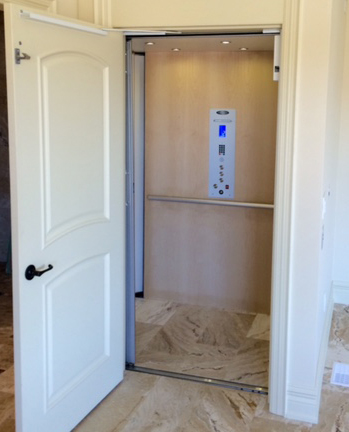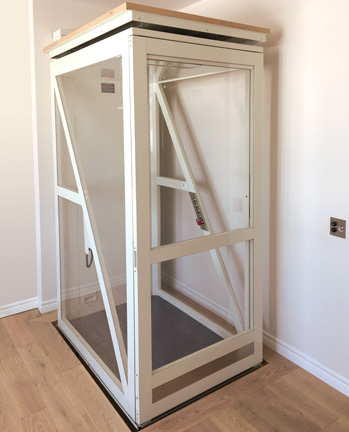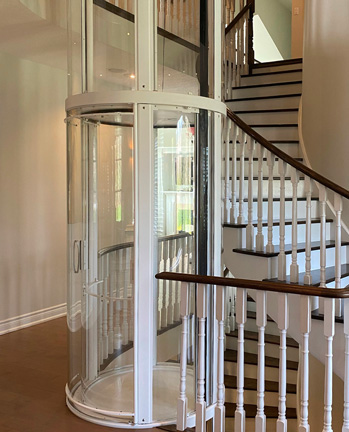Home » Home Elevators
Home » Home Elevators
A home elevator was once considered an extraordinary luxury, but today’s homeowners and home builders have made elevators for home use more popular as more people place more value on convenience and the ability to age in place, eliminating the burden or safety risks of using the stairs.
A private home elevator is a specialized version of a commercial elevator, with the same basic principles of operation. In North America, residential elevators should be built to meet certain code requirements that limit such things as the speed, size and capacity. Most home elevators require a shaft-way in which to travel. Modern designs feature automatic operation so they open, close and move with single touch buttons.
There are a variety of mechanical drive systems available to power a home elevator. The differences will be noticeable mostly in how quiet the elevator is when it operates and in how smooth the ride feels. Today’s home elevators can be finished inside to match the homeowner’s style and design tastes, including traditional hardwood interiors, sleekly modern materials and glass observation panels.
Adding a home elevator to an existing home may be possible if you have the required space on each level. Incorporating an elevator into your planned home renovation or when building a new home is certainly easier. Many new home builders are also incorporating elevators into their projects as standard or optional equipment. This makes a home easily accessible on all levels, allows owners to age-in-place, and accommodates visitors with mobility issues. Once you have a home elevator, you will use it to carry you and your laundry, your luggage, a baby stroller or your own mobility device.
There are two main categories of home elevators: traditional and specialty.
Traditional home elevators require a hoistway or shaftway to be built in which the elevator travels. This type of elevator operates using some type of cable or chain mechanism powered by a drive system. The drive system is housed in a machine room, or possibly on the elevator car top depending on the type of drive. The elevator cab includes a safety gate and each landing will also include a swing door or sliding doors.
Specialty home elevators do not require a hoistway to be built. This category includes through-the-floor elevators that travel through a floor cut-out, as well as elevators that include a manufactured hoistway, such as the Savaria Vuelift.



A locally trained residential elevator contractor or dealer will perform a site visit to assess the space you have and the construction requirements specific to your home. The best time to involve the contractor is when you are planning a new home or a major renovation. Not all home elevators have the same requirements, so it is imperative to select the elevator you want before the hoistway is constructed. The best manufacturers have free planning guides on their websites to provide information on the general requirements for hoistway construction, but again, do not have your hoistway built without discussing with the elevator installation company.
Your elevator will be custom built and programmed to travel from floor to floor with two stops or more. Each landing will have a call station button (hall call) installed and each landing will also require a special door that locks and cannot be opened unless the elevator is at the landing. The elevator itself should also have a cab door or gate to keep occupants safe while the elevator is in motion. Inside, the elevator will include a cab operating panel (COP) to allow the user to select the level desired or to stop the elevator in case of emergency.
Geared chain drive
A popular choice that is moderately priced. The geared chain home elevator uses a chain with a motor and counterweights to move the elevator up and down. It is generally regarded as a good quality ride, low maintenance and straight forward for the elevator installer. There are many variations of this style of drive including those that are quieter and smoother. Generally, drive systems cost more to reduce noise and increase the quality of the ride.
MRL (machine-roomless)
This option means that a separate machine room is not required for the elevator drive system. Instead, the drive is integrated into the elevator itself. This means less space is needed for installation, so an ideal choice when you do not have space nearby for a dedicated machine room.
Hydraulic drive
The elevator moves using power generated by moving pressurized hydraulic fluid through a cylinder. It is a very quiet and smooth ride in comparison to a chain drive elevator; however, typically more expensive than chain drives and more complex to install with a machine room required to house the drive system.
Winding drum
A winding drum elevator is a simple technology that uses winding cables. This technology has been used for many years and is still used today as it is reliable. It is also known to be space saving for small elevators or when the drive needs to be compact and not visible such as a glass elevator.
Vacuum tube
These elevators use air suction to move an elevator car up and down inside a plastic cylinder (just like mail moves through pneumatic tubes in large offices). The technology is not prevalent but is used for specialized home elevators.
Founded in 1993 when the Internet was just starting to become important in day-to-day life, Silver Cross built its roots as relationship company. It formed partnerships with experienced dealers and installers of stair lifts, elevators and other mobility equipment in order to bridge the gap between the prospective customer and a pre-qualified, knowledgeable local dealer.